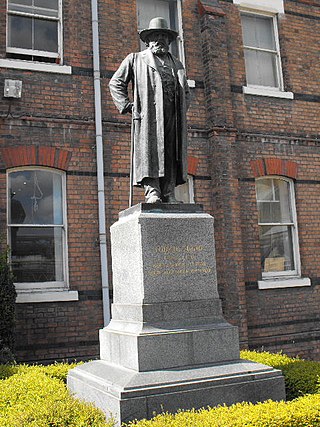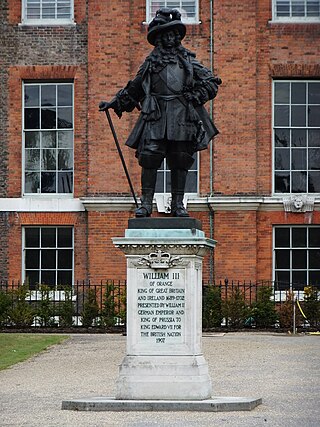
St John's Gardens is an open space in Liverpool, England, to the west of St George's Hall. The gardens are part of the William Brown Street conservation area, and comprise one of the two open spaces within Liverpool's World Heritage Site. It has been a Green Flag site since 2003. The gardens contain ornamental flower beds, and memorials to notable people of the city.

The Statue of Richard Grosvenor, Second Marquess of Westminster is in Grosvenor Park, Chester, Cheshire. England. It was designed by Thomas Thornycroft and was erected to commemorate the generosity of the Marquess. The statue was unveiled in 1869, and was paid for by public subscription. It is recorded in the National Heritage List for England as a designated Grade II listed building.

The equestrian statue of Viscount Combermere stands on an island in Grosvenor Road, Chester, Cheshire, England, opposite the entrance to Chester Castle. It commemorates his successful military career, and was made by Carlo Marochetti. It is recorded in the National Heritage List for England as a designated Grade II* listed building.

The Statue of Queen Victoria stands in front of Chester Crown Court in the forecourt of Chester Castle, Chester, Cheshire, England. It was unveiled in 1903, the sculptor was Frederick William Pomeroy, and the statue is recorded in the National Heritage List for England as a designated Grade II listed building.

Crewe War Memorial stands in the Municipal Square, in Crewe, Cheshire, England. It consists of a bronze sculpture of Britannia standing on a pedestal, itself on a square base. The sculptor was Walter Gilbert and the sculpture was cast in the foundry of H. H. Martin and Company. It was unveiled in 1924. The names of those killed in both world wars and in later conflicts are inscribed on bronze plaques around the base, and there are further inscriptions on the paving around the memorial. It originally stood in Market Square and was moved to Municipal Square in 2006. The memorial is recorded in the National Heritage List for England as a designated Grade II listed building.

The Boer War Memorial, also known as the South African War Memorial, stands in a prominent position in Queens Park, Crewe, England. It was erected in memory of local soldiers who had served or fallen in the Boer War, and consists of a bronze statue of soldier in uniform standing on a column on a stone plinth. The monument was unveiled in 1903, and contains plaques with the names of those who were lost in the war. It is recorded in the National Heritage List for England as a designated Grade II listed building.

Macclesfield Cenotaph is a World War I memorial in Park Green, Macclesfield, Cheshire, England. It was unveiled in 1921, and consists of a stone pillar and pedestal and three bronze statues. One statue is that of a mourning female, and the others comprise Britannia laying a wreath over a soldier who had died from gassing, an unusual subject for a war memorial at the time. The memorial is recorded in the National Heritage List for England as a designated Grade II* listed building.

The Memorial to John Whitaker is in Roe Street, Macclesfield, Cheshire, England. It stands in the forecourt of the Sunday School that Whitaker established in 1814, and was placed there in 1846 to commemorate the school's fiftieth anniversary. The memorial was sculpted by Alfred Gatley in stone and marble, and contains a bust of Whitaker in a medallion on the south face. The monument is recorded in the National Heritage List for England as a designated Grade II listed building.

The Statue of John Laird stands on the west side of Hamilton Square, Birkenhead, Merseyside, England. It commemorates the life of John Laird, a local ship builder, politician and benefactor. The statue was sculpted by Albert Bruce-Joy, and unveiled in 1877 by Lord Tollemache. It is recorded in the National Heritage List for England as a designated Grade II listed building.

Moulton War Memorial stands in Main Road, Moulton, Cheshire, England. It consists of a marble statue of a soldier standing on a sandstone pedestal, and is surrounded by a wrought iron fence. The memorial was designed by Samuel Welsby, and unveiled in 1920. It is recorded in the National Heritage List for England as a designated Grade II listed building.

The Statue of Ludwig Mond stands outside the entrance to Mond House in Brunner Mond Works, Winnington, Cheshire, England. Ludwig Mond was born in Germany but spent most of his working life in England. He moved to England in 1862 and joined the business of John Hutchinson in Widnes. Wishing to develop a better process for the production of alkali than the Leblanc process, he joined in partnership with John Brunner, who also worked for Hutchinson, to improve the ammonia-soda process, building a factory for this purpose at Winnington. In time the factory became the largest producer of soda in the world. Mond went on to work with other chemical processes, especially those involving nickel. He also became an art collector, bequeathing much of his collection to the nation. His statue was designed by Édouard Lantéri, and was unveiled by Brunner in 1913. It was moved in 1995 to stand next to the statue of Brunner in front of the offices of Brunner Mond in Winnington. The statue is recorded in the National Heritage List for England as a designated Grade II listed building.

The Statue of Sir John Brunner stands outside the entrance to Mond House in Brunner Mond Works, Winnington, Cheshire, England. Sir John Brunner was an English industrialist, politician and local benefactor. He joined the alkali manufacturing company of John Hutchinson in Widnes in 1861, eventually becoming the office manager. While working there one of its chemists, Ludwig Mond decided to leave and build a factory to produce alkali by the ammonia-soda process, and Brunner joined him as a partner. The factory was built at Winnington, and in time it became the largest producer of soda in the world. Brunner then took an interest in politics, and was elected as the Liberal Member of Parliament for Northwich, holding the seat for over 30 years. The business had made him a rich man, and he was a generous benefactor in the local area. His statue was designed by Goscombe John, and was unveiled in 1922. It was moved in 1995 to stand next to the statue of Mond in front of the offices of Brunner Mond in Winnington. The statue is recorded in the National Heritage List for England as a designated Grade II listed building.

The Boer War Memorial stands in the shopping precinct of Winsford, Cheshire, England. It consists of the statue of a soldier in uniform standing on a plinth, and it was unveiled in 1906. It originally stood on a different site in the town and was moved to its present position in the 1960s. In addition to recording the names of those who were lost in the conflict, it also contains the names of those who survived.

The Bootle War Memorial is in King's Gardens, Stanley Road, Bootle, Sefton, Merseyside, England. It was paid for partly by a grant from the local council, and partly by public subscription. The sculptor was Herman Cawthra, with assistance in the design from Hubert Ernest Bulmer, the borough's art director. The monument consists of a mother and child on top of an obelisk, which is surrounded by the figures of three servicemen. It was unveiled in 1922, and the names of those killed in the Second World War were added in 1948. The memorial was recorded in the National Heritage List for England as a designated Grade II listed building in 1986, and upgraded to Grade II* in 2018.

The Statue of Queen Victoria stands on the western side of Victoria Square, St Helens, Merseyside, England. It was created after the death of Queen Victoria and given to the town by Colonel William Windle Pilkington, mayor of St Helens in 1902, and a member of the Pilkington glass manufacturers in the town. Pilkington commissioned George Frampton to design it. Frampton used the same model for the figure of the queen for two other statues, but placed it on thrones and pedestals of different designs. The St Helens statue was unveiled by the Earl of Derby in 1905. Originally placed in the centre of Victoria Square, it was moved to a position on the west side of the square in 2000. The statue is recorded in the National Heritage List for England as a designated Grade II* listed building.

A Memorial to Queen Victoria stands in Woodhouse Moor, Leeds, West Yorkshire, England.

The Lifeboat Monument, St Annes, stands on South Promenade, St Annes, Fylde, Lancashire, England. It commemorates the death of 13 lifeboatmen from St Annes who were lost in the attempt to rescue the crew of the German barque Mexico that had been driven into a sandbank in a gale in December 1886. The lifeboat from Southport also lost 14 of its 16 man crew in the disaster. The monument depicts a lifeboatman looking out to sea and standing on a rock-like plinth. It is recorded in the National Heritage List for England as a designated Grade II listed building.

Southport War Memorial is in London Square, Lord Street, Southport, Merseyside, England. It consists of an obelisk flanked by two colonnades in the form of Greek temples. Outside the colonnades are memorial gardens, each containing a Pool of Remembrance and fountains. The memorial was designed by the local architects Grayson and Barnish, and the carving was executed by Herbert Tyson Smith. It was unveiled in 1923 by the Earl of Derby. Following the Second World War and subsequent conflicts further inscriptions and names have been added. The memorial is recorded in the National Heritage List for England as a designated Grade II* listed building.
Bootle is a town in Sefton, Merseyside, England. It contains 18 buildings that are recorded in the National Heritage List for England as designated listed buildings, Of these, one is listed at Grade I, the highest of the three grades, one is at Grade II*, the middle grade, and the others are at Grade II, the lowest grade. Bootle was a bathing resort in the early 19th century. Between 1860 and 1900 its population increased nearly ten-fold, due to the building of the Leeds and Liverpool Canal and the extension of the docks. Before this time, the only listed buildings are those relating to a shooting lodge of the Earl of Derby. The main civic buildings, most of which are no longer used for their original purposes, date from the later years of the 19th century. The other listed buildings are churches, buildings associated with the docks, a statue, and a war memorial.

A bronze statue of William III of England stands on the south side of Kensington Palace in London, facing towards the Golden Gates. The statue was designed by Heinrich Baucke and erected in 1907. It was cast by the Gladenbeck foundry in Berlin and given as a gift by the German Emperor Wilhelm II to his uncle, King Edward VII. The statue has been a Grade II listed building since 1969.




















